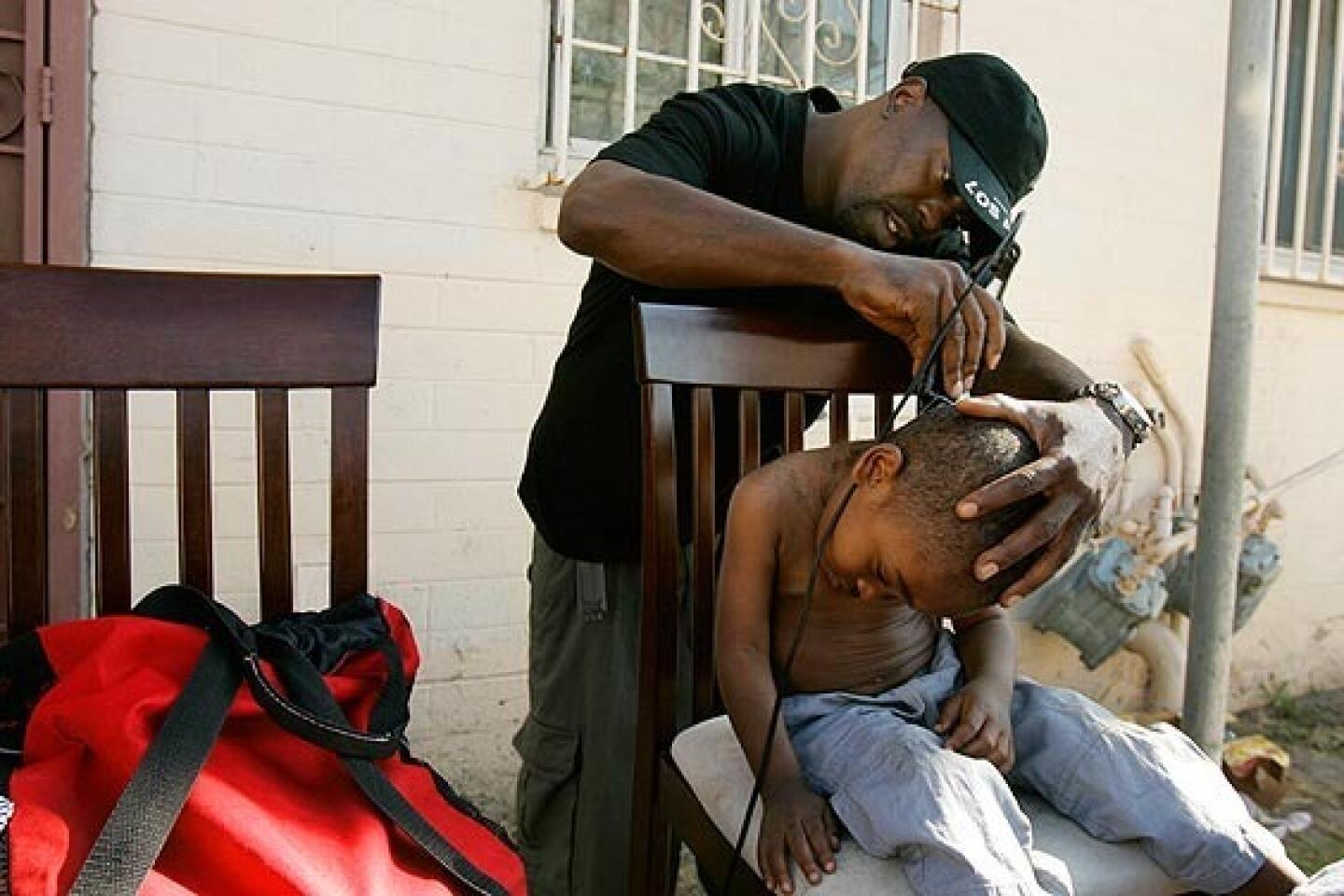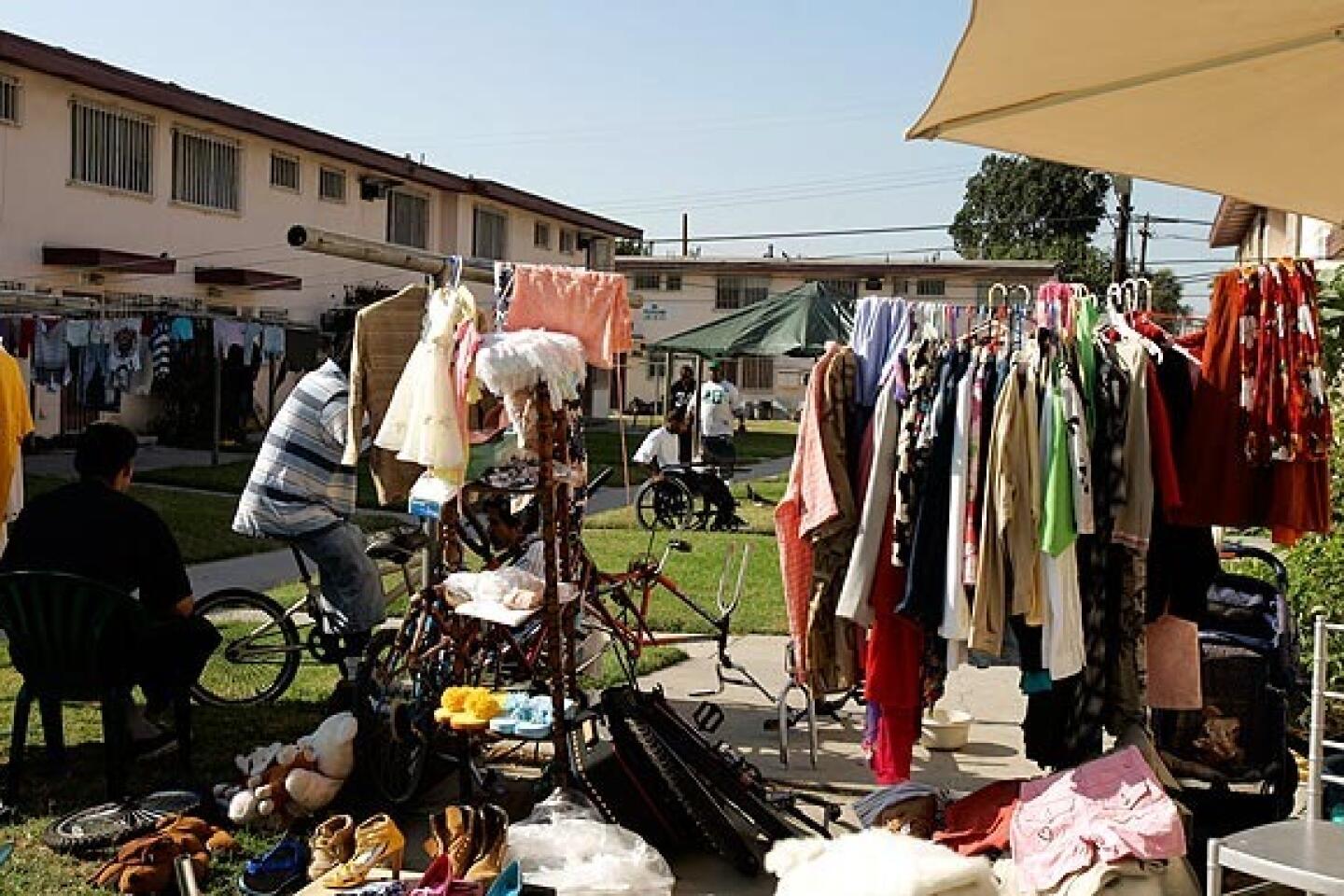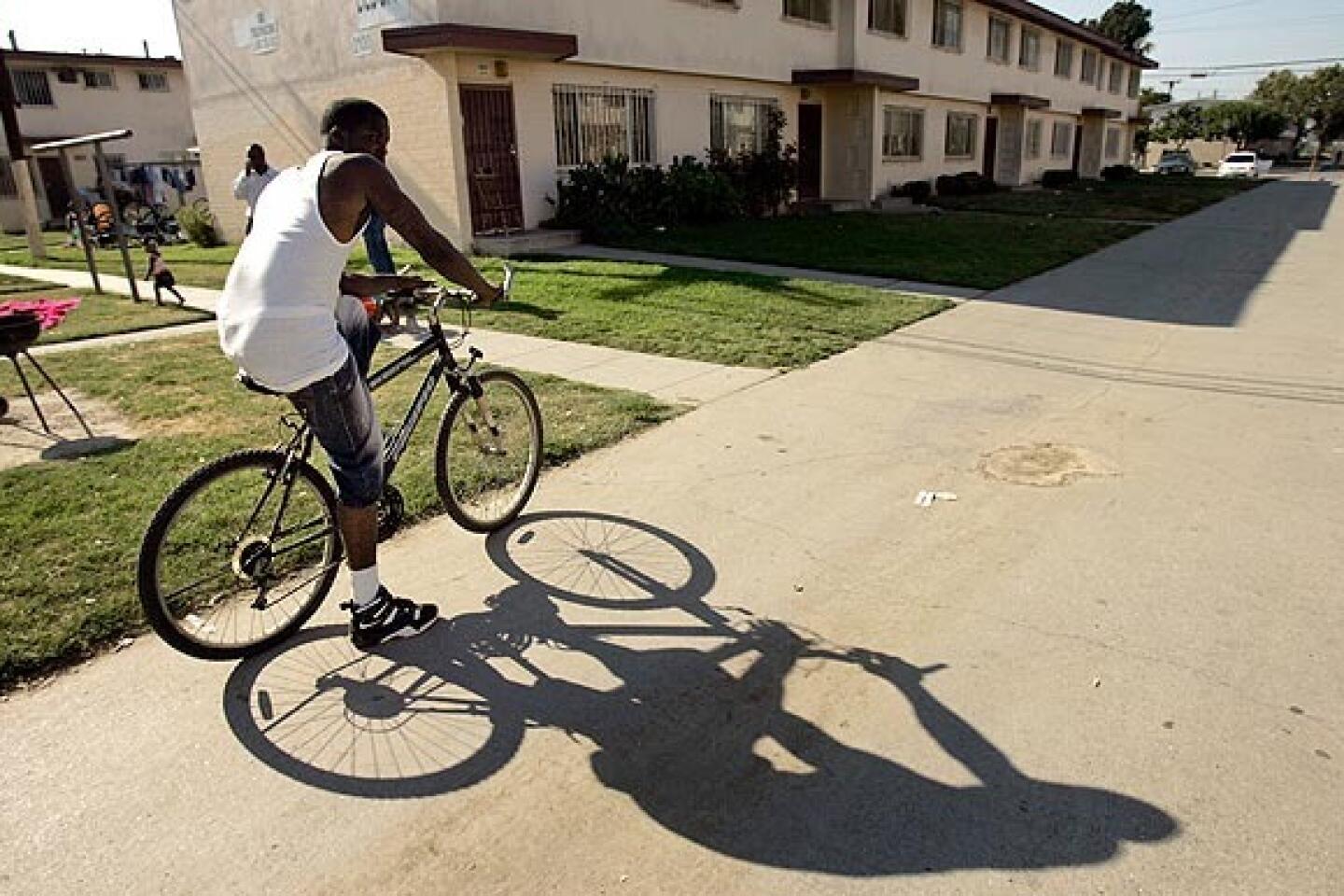Utopia is a hard sell in Jordan Downs
Ronald Perkins and his neighbors were nearly outnumbered by the consultants and architects who showed up at the Jordan Downs community center.
For three hours, they listened as a procession of planners depicted their home as an “island of poverty,” and dissected it by “landscape character and typologies.” But something puzzled Perkins as he studied the new homes that would replace their decrepit apartments in Watts. So when the tenants were asked for their opinions, he raised his hand: “How come I don’t see no bars on the windows?”
The young architect in charge of Perkins’ group brightened at the observation, plunging into an animated explanation of architectural innovations that would make the neighborhood so safe, “you won’t need bars on your windows and doors.”
Perkins took that in, leaned into a whispered conversation with his wife, then looked back at the architect.
“I think,” Perkins said, taking pains to be polite, “that I would feel better with bars of some type.”
Once again, the utopian vision of urban planners had run up against the gritty reality of project life.
The new Jordan Downs will cost more than $1 billion and take more than five years to complete. Current project residents will be moved into temporary housing across the street while their old homes are torn down and rebuilt. Then, if things go according to the master plan, they will move back into a new complex with middle-class neighbors, a bank of shops and businesses, and a cutting-edge high school campus next door.
“I think because of the focus on the people and the programs and the resources that are needed, that it’s very much going to be a success,” promised John King II, a planning director at the city’s Housing Authority.
Residents skeptical
So far, tenants are less than impressed. Many have spent their whole lives in the projects -- long enough to remember when a similar renewal proposal 20 years ago crumbled amid political resistance and tenants’ complaints.
Many suspect that this project is an excuse to kick them out of their subsidized apartments, where rents are based on family income; some say they pay less than $100 a month.
Others are weary of broken commitments, among them the city’s promise three years ago to install Internet access if tenants dropped objections to security cameras.
And some are just too busy trying to survive to worry about abstractions like “landscape typologies,” or choose between rooftop decks and community courtyards. Only about a dozen of Jordan Downs’ 700 families turn out consistently at architects’ planning sessions.
“The projects ain’t feeling this right now,” explained longtime resident Fred “Scorpio” Smith.
Aside from 13 years in the penitentiary, Smith, 37, has lived in Jordan Downs his whole life. He ticked off a string of tenants evicted for penny-ante transgressions, like elderly “Miss Lewis,” kicked out after 53 years, Smith said, when a project employee saw a set of clothes belonging to her 47-year-old son.
“He lives in Riverside. Showed them his address.” Still, Lewis was accused of violating her lease by harboring a tenant not on the lease, Smith said. “It’s like they got a secret list. You blink twice and you’re out.”
Such stories fuel conspiracy theories, particularly among blacks who have watched the population in the project shift from virtually all-black 40 years ago to more than two-thirds Latino today.
King concedes that there has been a crackdown on lease violators by a new staff installed to remedy years of mismanagement. Evictions are up, he said, but blacks are not being targeted.
“We’re just holding families accountable for what they should have been doing all along,” he said. Every tenant “in good standing” will be allowed to remain and return when the new homes are done, he added.
King, who grew up a few miles away, understands why Jordan Downs tenants don’t fully trust planners and public officials.
“Until they see it, it’s hard to get people to trust,” he said. “We’re trying to build that by delivering on what we say.”
Rep. Maxine Waters (D-Los Angeles), whose district includes Watts, has promised to protect residents’ interests, and they trust her. She and Mayor Antonio Villaraigosa plan to meet today with residents at Jordan Downs.
Planners have worked hard to generate tenants’ support. They took a team of locals on a national tour of similar redevelopment projects and have offered free lunches for tenants who sit through the marathon presentations and focus-group sessions.
They count on ambassadors such as Richard Alford, who lives a few blocks away but grew up in Jordan Downs; his grandmother, aunts and sisters still live in the projects. He visited Seattle, Chicago, Portland, Ore., and Atlanta with the team of architects designing the project.
“I whip out my pictures and [say] ‘Wouldn’t you like to get brand new pipes?’ ” he said. He tries to push tenants to ask for what they want, and assures them they won’t be shipped out to Lancaster and forgotten. “I tell them I’ve seen it with my own eyes.”
But even its biggest cheerleaders worry that the project might be undone by its homegrown web of challenges.
“Jordan Downs is the most extreme case I’ve seen, by a long shot,” said San Francisco architect Daniel Solomon, who heads the project’s planning team and has redeveloped other city projects.
“The project’s size, the sense of isolation, the horrible statistics about crime and public health . . . the sense of entrapment people feel there,” Solomon said, ticking off the consequences of a “history of abandonment” in South L.A.
To a stranger, Jordan Downs feels like a world unto itself. Stand in almost any spot on the 50-acre property and you see row after row of identical two-story buildings that look like barracks, distinguishable only by an occasional rosebush near a front door or the size of shirts on clotheslines crisscrossing every backyard.
But the bunkered uniformity that ties down residents also gives some comfort; there’s less shame being out of work or on welfare when almost everyone around you is as well. “There’s an amazing sense of community there, and they don’t want that dismantled,” Solomon said. “These are their homies, and they cannot imagine life without them.”
They also cannot imagine life alongside the middle-class families the project plans to lure.
‘Pollyannaish view’
“Upscale people are not going to move over here, to the heart of the ghetto,” said Smith, of Parolees for Change. “They’ll be, like: ‘Where are the gas stations? Who are all these dudes hanging around? Why did that guy take off with my car?’ ”
Smith took Solomon on a walking tour of the projects -- an eye-opener for the architect, who realized “they think we have a Pollyannaish view of their lives.” And “they” are right.
“Their daily experiences are so different from what anybody who doesn’t live in that environment can imagine,” Solomon said, recounting his introduction to a place where nobody blinks when the front-office receptionist explains that she is late because her 7-year-old son woke up to a dead body on their front step.
That reality seeps through residents’ contributions to the planning process.
The bars on every window and door might seem like evidence of urban blight to architects. But to residents like Perkins, they represent the freedom to sleep with a breeze blowing through an open window, while thieves prowl the neighborhood at night. (The bars were added back onto a tentative list of amenities).
At a community meeting last month, a middle-aged Latino man limped to the microphone, leaning on a walker, to present the suggestions from his group of neighbors.
“I know we can’t demand anything, “ he said, his voice rising over the interpreter translating his Spanish. “But I would like to make a request. We have a lot of vandalism in the area, and we are devastated by that. So we would like to have an inspector. Right now. Today.” He pounded the handle of his walker, and the women and children at the table behind him applauded.
Dose of reality
Then he went through their wish list for the new project: lighted bike paths, nearby markets and private backyards big enough for family barbecues and vegetable gardens.
Across the room, the black residents at Jenkins’ table nodded. In addition to safety bars, they wanted parking spots visible from their windows and playgrounds within shouting distance “so if something jumps off, I can get there before it’s too late,” one mother said.
At the meeting last month, one resident panned what planners figured would be a welcome draw: new businesses on-site and more frequent bus service. “Don’t you want a grocery store closer to Jordan Downs?” asked the architect.
Genevia Penny shrugged him off. The Food 4 Less is close enough, she said, and a 20-minute wait for the bus is no trouble.
A trip to the market is a good reason to get dressed and go out; the bus stop is a good place to catch up on neighborhood gossip.
“They want to make it so we don’t get out in the world,” Penny complained. “What’s the senior citizens like me supposed to do -- just sit around and watch TV?”
But if some sentiments have surprised the consultants, some suggestions have surprised the residents.
What about a health club, where elderly residents could exercise, one of the consultants offered. Or a computer center, where senior citizens could learn to use technology?
Penny stared at her with raised eyebrows, uncharacteristically silent. Twenty-four years in the projects and she had yet to consider all of its possibilities.
And if Miss Penny can check her e-mail on a computer in Jordan Downs, maybe her bedroom window won’t need bars after all.
More to Read
Sign up for Essential California
The most important California stories and recommendations in your inbox every morning.
You may occasionally receive promotional content from the Los Angeles Times.



















